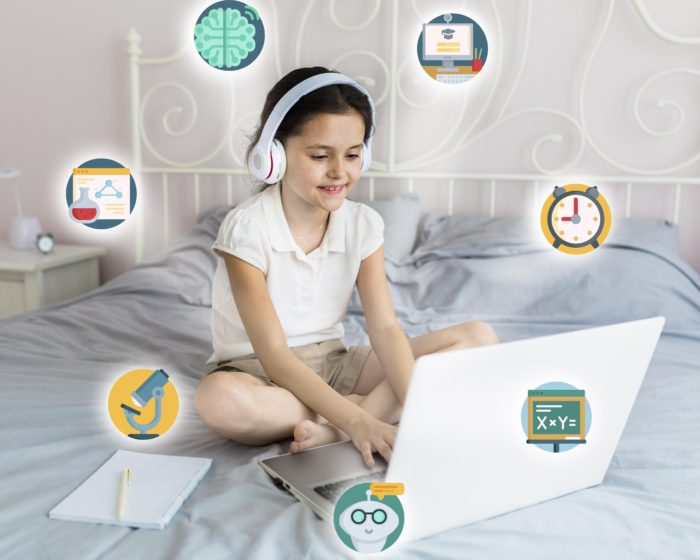- September 18, 2020 2:20 pm
- by Sooraj
- September 18, 2020 2:20 pm
- by Sooraj

Today, one of the most probable questions that come into the mind of an educator is, “How can I improve the effectiveness of teaching in an online environment?”. So, what exactly is online learning? Online learning can be defined as highly interactive tutoring that is online, instructor-led, and has defined learning objectives that are individually connected to students via a web-based platform. In order to deliver an interactive and engaging learning experience, there are some best practices that educators can possibly follow. We are going to explain exactly that in this blog post. If you follow these practices, you can increase the probability of providing an effective, efficient, and satisfying teaching experience in your next online class. So, let’s examine some of the best practices you can take as an educator to further develop online learning experience.
Out of all other practices, being present (both physically and mentally) in the virtual class environment is considered as an important practice a teacher can embrace. Similar to a face-to-face classroom, an active and consistent presence of instructors throughout the class is highly crucial for student success, especially in a virtual environment. In fact, research has shown that an online instructor’s presence is associated with effective teaching, greater depth of learning, and improved learner satisfaction with the learning process. As an instructor, it is important for them to build “communication bridges” to establish their role as a facilitator and mentor. Also, it is important to maintain a highly visible social and teaching presence, providing opportunities to connect with students via synchronous and asynchronous activities. Apart from that, instructors should be available to answer student queries no matter the day or the time unless explicitly communicated. A consistent faculty presence assures the students that they care about their queries throughout their program and guides them to have a greater understanding of course content. Here are some practical strategies for developing an active online presence.
During the inception of online learning, instructors more relied on primitive approaches such as pre-recorded classes to administer their courses. However, now we have access to an almost infinite number of dynamic online learning environments such as Learning Management Software(LMS), real-time classrooms, video conferencing platforms that support real-time chat, course management systems, online discussion portals, online exam portals, and much more. These tools facilitate faculties to do nearly everything that they do in a traditional classroom setup. In addition, they can also engage their students in more interactive, collaborative, and informative activities. If you are on the lookout for a Learning Management System for your institution and having difficulty in choosing one, it’s better to consult with an offshore software development company in India that has expertise in developing custom e-learning solutions.
Providing thoughtful feedback at the right time can improve the online learning experience for both students as well as instructors. A simple act of collecting feedback such as questions, comments, or suggestions from students can help them have a better course experience. Instructors can ask for feedback while the session is ongoing or soon after the course has ended. They can ask for feedback by digitally annotating (Most Learning Management Systems and video conferencing tools that are available in the market have a whiteboard feature that allows others in the session to share ideas realtime) or by sending a simple feedback form. Other ways of collecting feedback can be done by calling out a student randomly, which is pretty much similar to that of the practice that teachers normally do in a face-to-face classroom. During real-time online sessions, the use of polls can be a viable method to check for understanding within the students. This practice also helps instructors to modify their teaching in real-time. Additionally, the use of questionnaires and surveys throughout the course can help instructors to collect valuable feedback and data about their students. Whenever applicable, it is better to encourage students to share their personal experiences that connect to course content, especially during asynchronous discussions.
These are some of the questions that an instructor should surely ask after delivering an online session.
Beginning the course by setting clear expectations for students is one of the best practices in online learning that can encourage lean interaction among students. It is evident from recent studies about the relationships between clarity, consistency, and simplicity in course design. These findings support the clear goals and expectations for students. So, what practical strategies can instructors use to communicate clear goals and expectations? First, instructors should clearly state the hours they are available and their policy on responding to emails. This way students know the best way to contact their instructors and when to expect a response. Additionally, setting up norms for student behavior can be a viable strategy in ensuring smooth communication between instructors and students.
Demonstrating students how they can apply what they have learned in a real-world scenario will help students to understand their learning concepts much faster. Exposure to these kinds of multiple learning styles and real-world examples increases a student’s ability to adapt to real-world situations. This set of top five best practices can be really helpful in developing expertise in teaching online, especially while using a Learning Management System.
Guaranteed Response within One Business Day!

How Much Does It Cost to Design an App?

Angular Best Practices For Web Applications

How to Set Up a Development Environment in React.JS?

What are the 6 Models Used In SDLC?

Why React Front-End Development is the Best